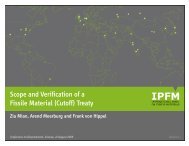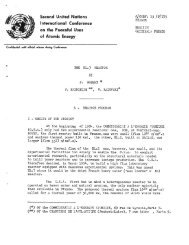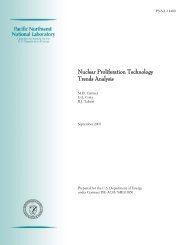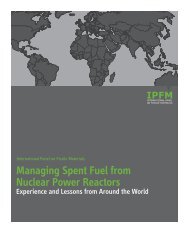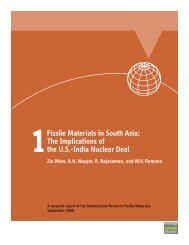Global Fissile Material Report 2009: A Path to Nuclear Disarmament
Global Fissile Material Report 2009: A Path to Nuclear Disarmament
Global Fissile Material Report 2009: A Path to Nuclear Disarmament
Create successful ePaper yourself
Turn your PDF publications into a flip-book with our unique Google optimized e-Paper software.
China. Over the past year, there appear <strong>to</strong> have been no significant changes in China’snuclear arsenal or major announcements of policy. The <strong>2009</strong> edition of the U.S. Departmen<strong>to</strong>f Defense report Military Power of the People’s Republic of China suggests a continuingeffort <strong>to</strong> move <strong>to</strong>wards more mobile and survivable delivery systems, includingtransitioning from liquid-fuel <strong>to</strong> solid-fuel road-mobile missiles and <strong>to</strong> submarinelaunched ballistic missiles. 14<strong>Nuclear</strong>-weapon and component sites<strong>Nuclear</strong> weapons can be found at a large number of sites around the world. It is estimatedthere may be a <strong>to</strong>tal of 111 nuclear warhead s<strong>to</strong>rage sites, with 105 of these sites innuclear weapon states. The United States currently maintains six sites in non-weaponstates—with one site each in Belgium, Germany, the Netherlands and Turkey and twosites in Italy. 15 In the past, the United States stationed nuclear weapons in as many as23 foreign countries. 16 Table 1.2 gives the <strong>to</strong>tal number of warhead and nuclear-components<strong>to</strong>rage sites currently estimated in each country. Appendix B <strong>to</strong> this report givesa preliminary listing of these sites for each country.CountryWarhead s<strong>to</strong>rage sitesChina 14France 7India 5Israel 4Pakistan 8Russia 48United Kingdom 4United States (domestic) 15United States (in five foreign countries) 6Total 111Table 1.2. Estimated number of nuclear warheads<strong>to</strong>rage sites by country. There are currently anestimated 111 warhead s<strong>to</strong>rage sites worldwide, inat least 13 countries, not including North Korea. Insome cases sites are counted twice, when there arewarheads deployed on missiles and spare warheadsat nearby s<strong>to</strong>rage areas. Source: Hans Kristensenand Robert S. Norris, FAS/NRDC.Russia accounts for almost half of all the nuclear warhead s<strong>to</strong>rage sites worldwide. Thisis in part due <strong>to</strong> Russia’s large number of tactical nuclear warheads, which are ordinarilyat a small number of national-level s<strong>to</strong>rage sites but for which s<strong>to</strong>rage areas are heldready at a much larger number of air and naval bases. The United States has withdrawnall but 500 tactical weapons from operational service and has mostly dismantled theretired weapons.<strong>Nuclear</strong> Weapon Free Zones. In March <strong>2009</strong>, Kazakhstan, Kyrgyzstan, Tajikistan, Turkmenistanand Uzbekistan established the Central Asian <strong>Nuclear</strong> Weapon Free Zone. 17It is the first nuclear-weapon free zone in the Northern Hemisphere and breaks newground by requiring its parties <strong>to</strong> accept an Additional Pro<strong>to</strong>col agreement with the InternationalA<strong>to</strong>mic Energy Agency (IAEA) and <strong>to</strong> become parties of the Comprehensive<strong>Nuclear</strong> Test-Ban Treaty.<strong>Global</strong> <strong>Fissile</strong> <strong>Material</strong> <strong>Report</strong> <strong>2009</strong> 11




